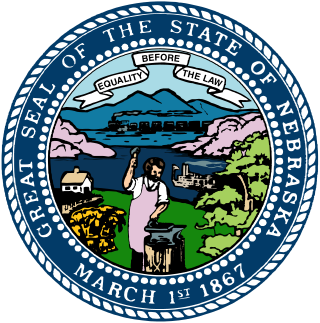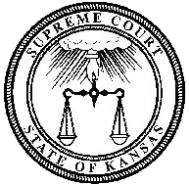Related Research Articles
The government of the U.S. state of Missouri is organized into the state government and local government, including county government, and city and municipal government.
The Missouri Plan is a method for the selection of judges. It originated in Missouri in 1940 and has been adopted by many states of the United States. Similar methods are used in some other countries.

The Tennessee Supreme Court is the highest court in the state of Tennessee. The Supreme Court's three buildings are seated in Nashville, Knoxville, and Jackson, Tennessee. The Court is composed of five members: a chief justice, and four justices. As of September 1, 2023, the chief justice is Holly M. Kirby.

The Supreme Court of Florida is the highest court in the U.S. state of Florida. It consists of seven justices—one of whom serves as Chief Justice. Six members are chosen from six districts around the state to foster geographic diversity, and one is selected at large.
The Alaska Court System is the unified, centrally administered, and totally state-funded judicial system for the state of Alaska. The Alaska District Courts are the primary misdemeanor trial courts, the Alaska Superior Courts are the primary felony trial courts, and the Alaska Supreme Court and the Alaska Court of Appeals are the primary appellate courts. The chief justice of the Alaska Supreme Court is the administrative head of the Alaska Court System.

The Indiana Supreme Court, established by Article 7 of the Indiana Constitution, is the highest judicial authority in the state of Indiana. Located in Indianapolis, the Court's chambers are in the north wing of the Indiana Statehouse.

The Supreme Court of Oklahoma is a court of appeal for non-criminal cases, one of the two highest judicial bodies in the U.S. state of Oklahoma, and leads the judiciary of Oklahoma, the judicial branch of the government of Oklahoma.

The Nebraska Supreme Court is the highest court in the U.S. state of Nebraska. The court consists of a chief justice and six associate justices. Each justice is initially appointed by the governor of Nebraska; using the Missouri Plan, each justice is then subject to a retention vote for additional six-year terms. The six associate justices each represent a Supreme Court district; the chief justice is appointed at-large.

The government of the U.S. State of Oklahoma, established by the Oklahoma Constitution, is a republican democracy modeled after the federal government of the United States. The state government has three branches: the executive, legislative, and judicial. Through a system of separation of powers or "checks and balances," each of these branches has some authority to act on its own, some authority to regulate the other two branches, and has some of its own authority, in turn, regulated by the other branches.

The Oklahoma Judicial Nominating Commission is the judicial nominating commission of the U.S. state of Oklahoma. It selects potential justices and judges for gubernatorial appointments for judges for state appellate courts.

The Kansas Supreme Court is the highest judicial authority in the U.S. state of Kansas. Composed of seven justices, led by Chief Justice Marla Luckert, the court supervises the legal profession, administers the judicial branch, and serves as the state court of last resort in the appeals process.

The New Mexico Supreme Court is the highest court in the U.S. state of New Mexico. It is established and its powers defined by Article VI of the New Mexico Constitution. It is primarily an appellate court which reviews civil and criminal decisions of New Mexico's trial courts of general jurisdiction and certain specialized legislative courts, only having original jurisdiction in a limited number of actions. It currently resides in the New Mexico Supreme Court Building in Santa Fe.
The Judiciary of Colorado is established and authorized by Article VI of the Colorado Constitution as well as the law of Colorado. The various courts include the Colorado Supreme Court, Colorado Court of Appeals, Colorado district courts, Colorado county courts, Colorado water courts, and municipal courts. The administration of the state judicial system is the responsibility of the Chief Justice of the Colorado Supreme Court as its executive head and is assisted by several other commissions. In Denver, the county and municipal courts are integrated and administratively separate from the state court system.

The Oklahoma Court of Civil Appeals is an intermediate appellate court in the state of Oklahoma. Cases are assigned to it by the Oklahoma Supreme Court, the state's highest court for civil matters.

The government of the U.S. state of Kansas, established by the Kansas Constitution, is a republican democracy modeled after the Federal Government of the United States. The state government has three branches: the executive, the legislative, and the judicial. Through a system of separation of powers, or "checks and balances," each of these branches has some authority to act on its own, and also some authority to regulate the other two branches, so that all three branches can limit and balance the others' authority.
A judicial nominating commission in the United States, is a body used by some U.S. states to recommend or select potential justices and judges for appointments by state governments.
The Judiciary of California or the Judicial Branch of California is defined under the California Constitution as holding the judicial power of the state of California which is vested in the Supreme Court, the Courts of Appeal and the Superior Courts. The judiciary has a hierarchical structure with the California Supreme Court at the top, California Courts of Appeal as the primary appellate courts, and the California Superior Courts as the primary trial courts.
The judiciary of Massachusetts is the branch of the government of Massachusetts that interprets and applies the law of Massachusetts, ensures equal justice under law, and provides a mechanism for dispute resolution. The judicial power in Massachusetts is reposed in the Supreme Judicial Court, which superintends the entire system of courts.
Kate M. Fox is an American lawyer who has served as the chief justice of the Wyoming Supreme Court since 2021.
Keith G. Kautz is an American lawyer who served as a justice of the Wyoming Supreme Court from 2015 to 2024. He previously served as a judge of the Wyoming District Court from 1993 to 2015.
References
- ↑ Choosing judges iaals.du.edu
- 1 2 "KS Courts - Supreme Court Nominating Commission".
- ↑ "Kansas Supreme Court Nominating Commission". Ballotpedia.
- ↑ "Kansas Supreme Court".
- ↑ List of commission members from Supreme Court's web page.
- ↑ Hanna, John (3 February 2016). "Stand fast against latest attempt to control Kansas courts". The Kansas City Star. Retrieved 30 July 2023.
- ↑ "StackPath" (PDF). www.fed-soc.org. Retrieved 30 July 2023.
- ↑ "Statutes & Constitution :View Statutes : Online Sunshine". www.leg.state.fl.us. Retrieved 30 July 2023.
- ↑ "Appellate Judicial Commission".
- ↑ "UJS Home".
- ↑ "Tennessee Governor's Council for Judicial Appointments".
- ↑ "JudicialNominatingCommission - Wyoming Judicial Branch". Archived from the original on 2016-01-20. Retrieved 2016-02-11.
- ↑ "About JNC | JNC".